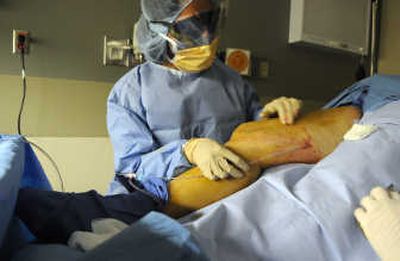Latest laser procedure removes varicose veins without pain

Christy Kerrick-Malen remembers what her mother went through some 20 years ago to get rid of her varicose veins.
“It was awful,” Kerrick-Malen said. “I think she had over 60 incisions. She had to stay in the hospital. And her recovery at home was miserable.”
That was back when a procedure known as “stripping” was the go-to treatment for knotted, painful varicose veins. In vein stripping, a surgeon makes small incisions and pulls out the diseased veins.
Kerrick-Malen, a 39-year-old Spokane mother and pharmacist, started noticing her own rope-like varicose veins in her 20s and was not looking forward to undergoing her own vein stripping procedure.
And then the veins really started bothering her, causing swelling, burning and tingling. Looking through a magazine at Rockwood Clinic one day, she read about a fairly new treatment for varicose veins, one that uses lasers to kill off damaged veins instead of surgically removing them.
She had laser ablation on her left leg last October and on her right one just last month.
“It was just such a breeze,” she said, adding that the only painful part was when the surgeon injected numbing medication. “I couldn’t believe it.”
Her legs feel – and look – much better, she says.
“Once the faucet’s been turned off, so to speak, then you don’t have the pooling of all the blood in the lower legs,” Kerrick-Malen says. “Now they’re disappearing. I used to have a lot of swelling. My legs would be hot, tingling, burning, all of that.”
Faulty valves and weakened vein walls can cause blood to pool, pressure to build and veins to bulge. These bulging veins, which can poke through the skin like thick rope, are called varicose veins and they can lead to a host of problems – from aching and swelling to skin ulcers that refuse to heal.
Mary Damascus, 58, coordinator of professional development for the Central Valley School District, knows too well the aching and heaviness of varicose veins. Damascus, who lives in Spokane, would like to train to walk a marathon. But after going seven or eight miles, she says, her legs get too sore to continue.
So, she spent Friday morning at Valley Hospital and Medical Center with Dr. Renu Sinha of the Rockwood Clinic Vein Institute.
Damascus, her pink-cased iPod loaded with U2 and Andrea Bocelli, laid back while a technician used ultrasound to pinpoint her problem veins.
“OK. You might feel a little pressure,” Sinha told her, as she threaded a guide wire into the great saphenous vein, the most common culprit behind varicose veins.
“I don’t feel a thing,” Damascus replied. “Are you doing anything?”
“Yeah,” Sinha said. “I’m in your vein.”
After injecting numbing medication throughout the area, Sinha inserted the laser into Damascus’ vein. The high-pitched hum of the laser filled the small procedure room. Bright spots appeared on the ultrasound screen as the laser’s energy sealed shut the problem areas of the vein.
“OK. That’s it,” Sinha said less than two minutes later, before applying a tiny bandage to the incision.
Next, Sinha set out to tackle some of smaller veins lower on Damascus’ leg using sclerotherapy, another alternative to invasive techniques. Sinha mixed a syringe full of a foaming chemical – sodium tetradecyl sulfate – and injected it into the vein, again using ultrasound to guide her way.
“We want to irritate these veins to stimulate them to close themselves,” Sinha said, adding that foam adheres to the vein walls better than liquid, which absorbs into the blood stream more quickly.
Sclerotherapy is also used to diminish the appearance of spider veins.
Stripping is still used in some of the most severe cases of varicose veins. Laser treatment, though, has made more people willing to get their veins treated before reaching that late stage, says Terri Porcarelli, a registered diagnostic medical sonographer with Vein Clinics Northwest in Coeur d’Alene.
“If you have open ulcers on the legs, you don’t have a normal life,” Porcarelli says. “We can heal them. It’s wonderful.”
Patients undergoing laser treatment will likely feel some pain and see some bruises in the days following the procedure. They’re asked to wear compression stockings for a short time and to avoid heavy aerobic activity for a week or two. In very rare cases, the laser treatment can cause deep-vein blood clots that can travel to the lungs, causing a life-threatening condition.
People with severe varicose veins may need several procedures to be completely satisfied, Sinha says.
“Most people need one treatment and that takes care of the major problems,” she says. “And then we can do clean-up.”
Kerrick-Malen, who underwent the laser ablation treatment, was scheduled to return late last week for sclerotherapy to take care of some of her smaller veins.
“My legs are so much better,” she says.